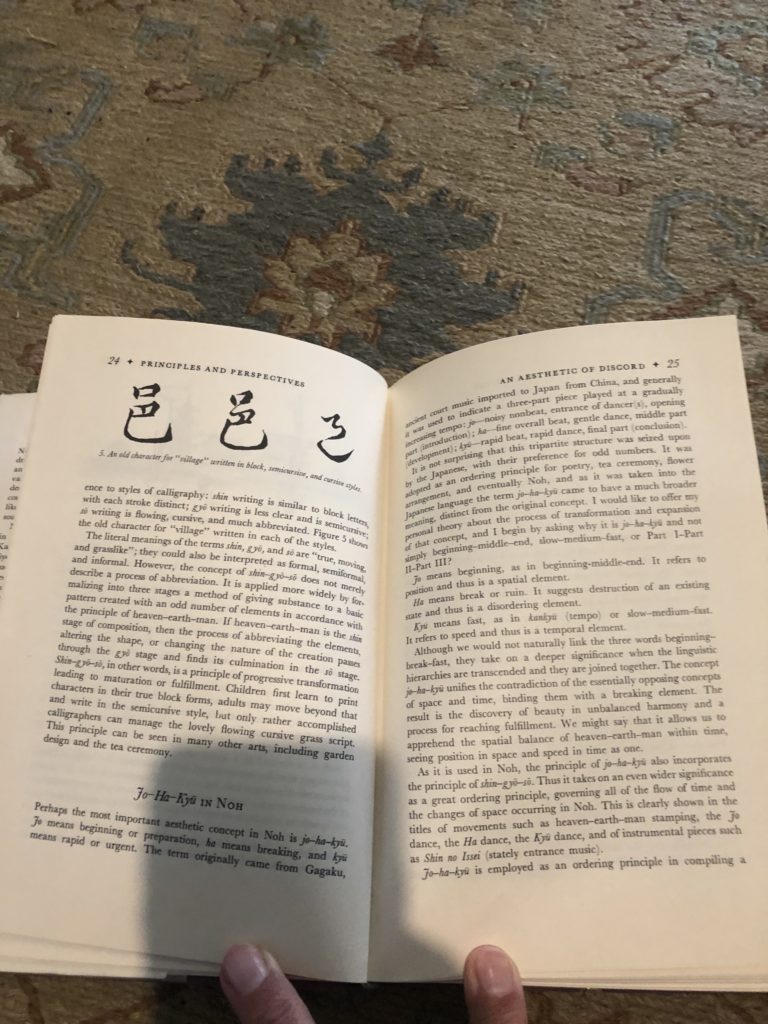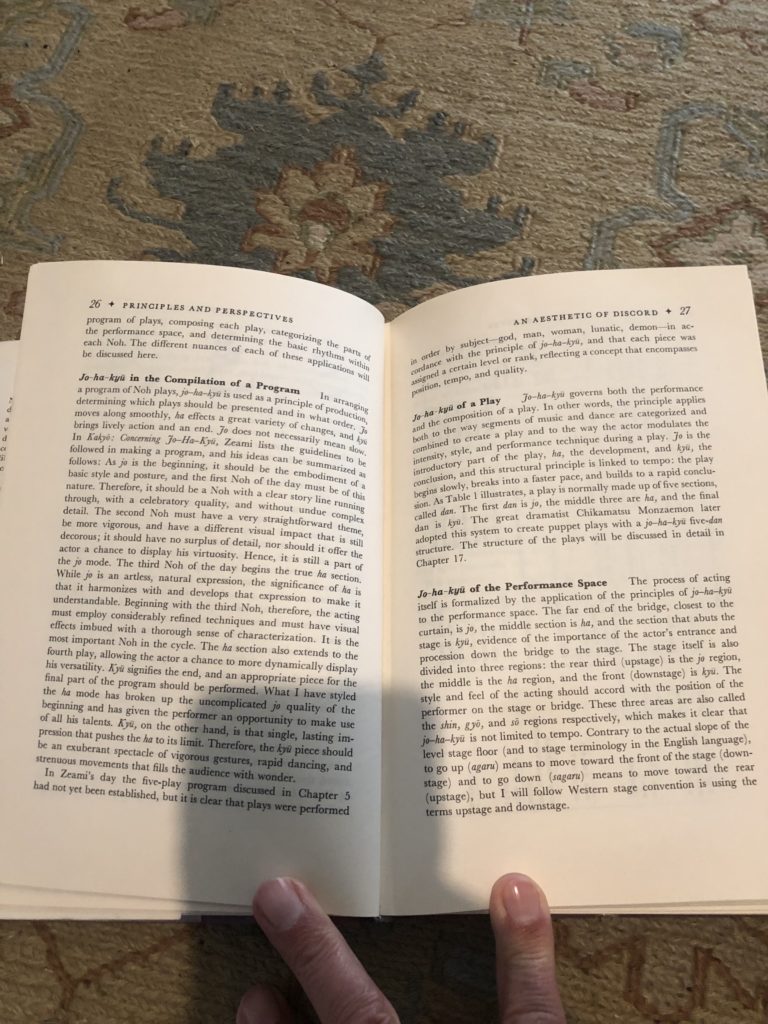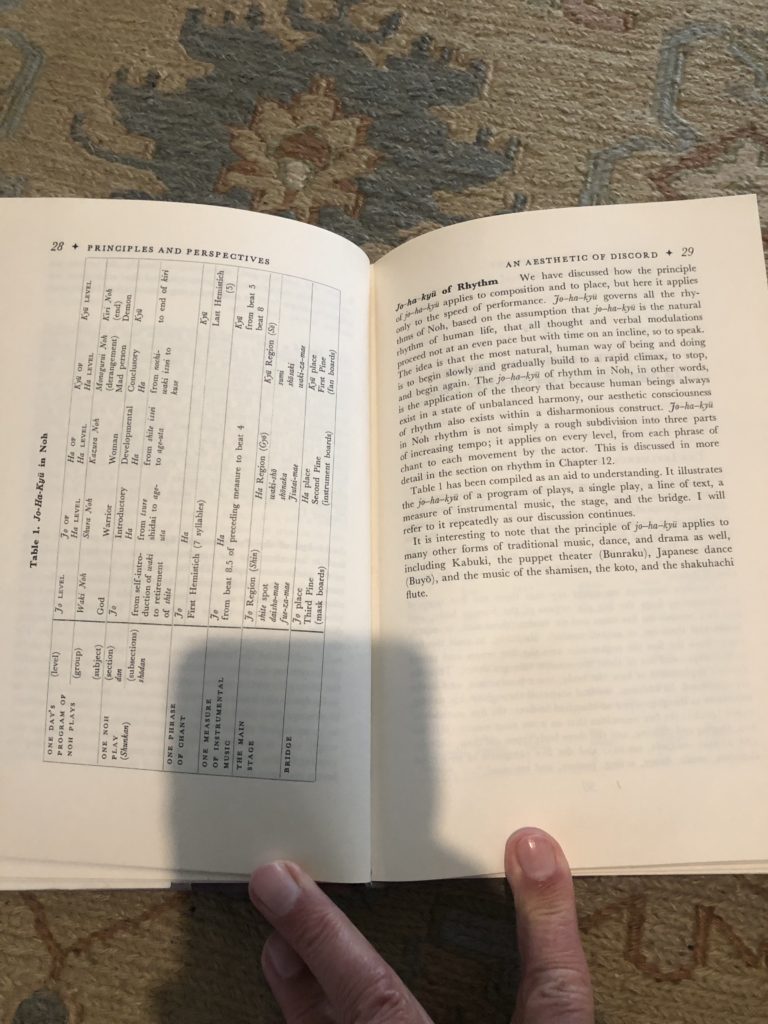Today I was asked: What does jo-ha-kyu mean in your Jo-Ha-Kyu Exercise because several of my students have asked me? I replied first that people should use google, youtube, libraries when they have a question, so did you look it up? That teacher of my method did a quick search on www and found a good answer. Here is my follow-up reply.
That’a a beautiful interpretation. Jo-Ha-Kyu is a 3 phase principle or principle of 3 phases. The origin I believe is either from Zeami or his Father who taught him Noh. Whereas Zeami is the person who codified it (Noh Theatre). I think Zeami described Jo-Ha-Kyu as a flower buding blooming dying. It can also be beginning middle end etc. I’ll photograph the pages from one of my few Noh books and send you those pages. I call the exercise Jo-Ha-Kyu to reference my inspiration taken from Asian theatre practices like martial arts of – power, control, calm. The Jo-Ha-Kyu Exercise is also structurally valuable because it follows right after The All-Inclusive Mime Exercise which MUST be done slow to feel the fingers. Whereas in J H Kyu we work fast and strong with the fingers spread in J H but in K is when we apply the fingers FIRST to come fully alive. This is a great secret in great acting and clown and performance WHEN combined with The Principle of Four!!!! (see the book Quantum Theatre: Slapstick to Shakespeare for the method’s Ten Principles which form the overarching structure of the method). Videos of those two exercises are posted in the end of this blog.
The Principle of Four, certainly is a key to my whole method. The Principle of Four is encapsulted and tested in the 1st of The Seven Solos. That 1st creative solo is The Creative Twist.
The Principle of Four is the integration of Body-Voice-Creativity-Performance. In the exercise the actor learns how to load up their ki/chi or creative power instantly.
I used The Creative Twist before every performance on my short “Replacement Contract” for Cirque du Soleil. That contract allowed me in its time to only do 104 performances in Corteo. 102 were as The White Clown and for technical reasons to complete my preparation I did 2 performances as The Dead Clown i.e. the main role in the show.
Early each day (including during my weeks of rehearsal in Montreal) I did my own training, Then for my two performance seasons in L.A. I would do early training daily and finish with back flips. Later in the day/evening I did a pre-performance warmup.
However, just before each performance commenced I did The Creative Twist in costume and in the backstage entrance area. As I did that the young artists would arrive for our ensemble entrance to start the show. I had to do The Creative Twist in an adjusted way due to limits in the space. I am not sure when the Accordian Player began to improvise with me as she also awaited her entrance.
As said, I did my own daily training that finished with back flips as we had a mat I could use. But years before when I was an active theatre clown doing my own work, my show warmup completed with either back flips (back handsprings) or back saltos (if I was going to use salto at the end of the particular show). As such, either flip or salto in those warmups I did barefoot on a hard wooden floor. I would have done my own training early in the morning. I would do a complete pre-show warmup. But I would do something just minutes before I made my first entrance in any show.
At the time in those years I very much considered performance a sacred and spiriual act of sacrifice. That was in the early years practical because I was going to improvise a lot and was quite physical so I was in fact doing something dangerous in the performances. So I needed to get my mind, heart, body in harmony and strength of character.
Jo-Ha-Kyu also represents the passing of time and use of time. The method’s Principle of Three is Time-Timing-Timelessness. See the book Quantum Theatre: Slapstick to Shakespeare (Kindle); and the 45-page blog essay “What Does A Clown Know… “.
“Passing Time” was the name of a show I created along with my partner at the time. That video is on youtube and starts with a very long solo section of mine followed by a short solo of my partner which dovetails into the duet story.
The Principle of Three and Principle of Four are practically speaking essential to everything I do in the performing arts be it teaching, directing, or acting for stage or screen.
These are things which the vast majority of actors and clowns either do not know or do not understand or do not use enough. The genre doesn’t matter, it could be dance or circus or Shakespeare. Whatever the genre, style, aesthetic or project there are Universal Principles as articulated in the complementary pair of books: Clown Secret and Quantum Theatre: Slapstick to Shakespeare.
Notably as these are Universal Principles for performance then they are also in Noh Theatre and many other forms. Notably, Noh was actually and Indigenous form but was codified and refined by Zeami.
Any excellent show in any genre of performance is excellent because the creator/director has utilised the same Universal Principles. I have ‘only’ codified them. I have also created a shortcut system of training those Universal Principles in a sucinct way called The Four Articulations for Performance.
Back to time-timing-timelessness – all of my work and exercises are time-based. That includes exercises in which time is open ended. I frequently say within my classes, workshops, rehearsals: “When you’re ready” and “Take your time”. When necessary, I will occasionally point out ‘that was too slow’ or ‘that was too fast’. Meaning too slow or too fast for that particular practitioner to work to their best capacity.
The long blog 4-parts essay “What Does A Clown Know… ” is based on The Four Articulations i.e.: Body; Space; Time; Space-Time Continuum. As mentioned within The Four Articulations is a sequence of 7 creative exercises called The Seven Solos. The 4th solo is: The All-Inclusive Mime Exercise; and, the 5th one is: The Jo-Ha-Kyu Exercise. They and all of The Four Articulation exercises are explained with step-by-step instructions in the book Clown Secret – the whole of chapter 2.
None-the-less here are two super short demonstration videos. You can get the instructions via the book in 2 minutes via Kindle. SUPER SHORT EXPLANATION AND DEMO…..
AND BELOW IS A SUPER SHORT EXPLANATION AND DEMO OF THE JO-HA-KYU EXERCISE
Here are the main pages about JO-HA-KYU from the book THE NOH THEATER: Principles and Perspectives (1983) by Kunio Komparu.
The 1st photo/page briefly discusses Noh’s use of integers. Integers are integral to The Four Articulations for Performance as mentioned in the blog “What Does A Clown Know… “.



